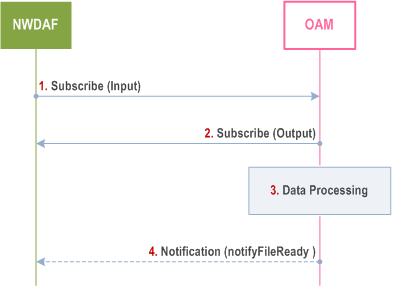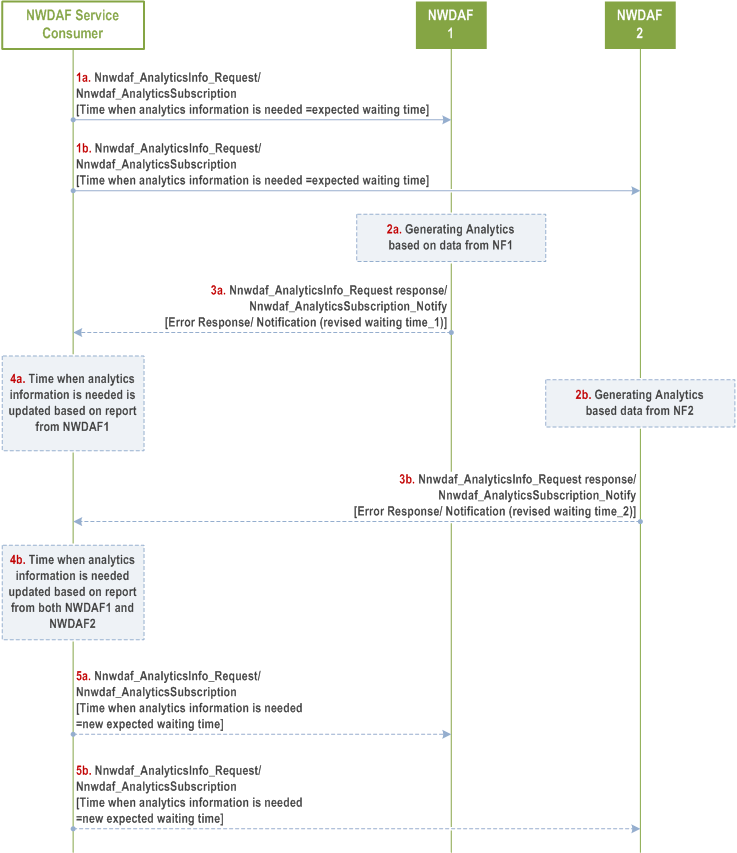Content for TS 23.288 Word version: 18.6.0
1…
4…
5…
5A…
6…
6.1.3
6.1.4…
6.1.4.4…
6.1.5…
6.1A…
6.1B…
6.1B.2.3…
6.1C
6.2…
6.2.3…
6.2.6…
6.2.6.2
6.2.6.3…
6.2.6.3.3
6.2.6.3.4
6.2.6.3.5
6.2.6.3.6…
6.2.7…
6.2.8…
6.2.9…
6.2.13…
6.2A…
6.2B…
6.2B.3
6.2B.4…
6.2C…
6.2D…
6.2E…
6.2F…
6.3…
6.4…
6.5…
6.6…
6.7…
6.7.3…
6.7.4…
6.7.5…
6.8…
6.9…
6.10…
6.11…
6.12…
6.13…
6.14…
6.16…
6.17…
6.18…
6.19…
6.20…
6.21…
7…
7.4…
7.7…
7.9…
8…
9…
10…
6.2.3 Data Collection from OAM
6.2.3.1 General
6.2.3.2 Procedure for data collection from OAM
6.2.4 Correlation between network data and service data
6.2.5 Time coordination across multiple NWDAF instances
6.2.5.1 General
6.2.5.2 Procedure for time coordination across multiple NWDAFs
...
...
6.2.3 Data Collection from OAM p. 80
6.2.3.1 General p. 80
The NWDAF may collect relevant management data from the services in the OAM as configured by the PLMN operator.
- NG RAN or 5GC performance measurements as defined in TS 28.552.
- 5G End to end KPIs as defined in TS 28.554.
- Generic performance assurance and fault supervision management services as defined in TS 28.532.
- PM (Performance Management) services as defined in TS 28.550.
- FS (Fault Supervision) services defined in TS 28.545.
- MDA (Management Data Analytics) services as defined in TS 28.104.
- Measurement collection for MDT as defined in TS 37.320.
6.2.3.2 Procedure for data collection from OAM p. 80
The interactions between NWDAF and OAM for data collection are illustrated in Figure 6.2.3.2-1. The data collected depends on the use cases. This Figure is an abstraction of the OAM performance data file report management service that is defined TS 28.532. The actual OAM services and reporting mechanisms that NWDAF may use are specified in TS 28.532, TS 28.550 or TS 28.545.
The flow below assumes the NWDAF is configured on how to subscribe to the relevant OAM services.
OAM shall setup the required mechanisms to guarantee the continuous data collection requested by NWDAF.

Step 1.
As the final step, NWDAF fetches data by using file transfer protocols as defined in clause 11.6.2 of TS 28.532.
(Clause 11.6.1.3.2 of TS 28.532), Subscribe (Input): NWDAF subscribes to the notification(s) related to the services provided by the management service producer.
Step 2.
(Clause 11.6.1.3.3 of TS 28.532), Subscribe (Output): management service producer responses to NWDAF if the subscription is success or not.
Step 3.
Data processing: management service producer prepares the data.
Step 4.
(Clause 11.6.1.1 of TS 28.532), Notification (notifyFileReady): management service producer notifies the data file is ready.
6.2.4 Correlation between network data and service data p. 81
The Correlation information in input data which helps NWDAF correlate data from different NFs, OAM and UE application(s) is defined in Table 6.2.4-1, which is subject to all the network data analytics.
| Correlation Information | Description |
|---|---|
| Timestamp, IP address 5-tuple | To correlate the data from AF and from UPF. |
| Timestamp, AN Tunnel Info (Clause 9.3.2.2 of TS 38.413) | To correlate the UPF data and OAM data which are reported by the RAN (e.g. Reference Signal Received Power or Reference Signal Received Quality as defined in Table 6.4.2-3). |
| Timestamp, UE IP address | To correlate the data from UPF and SMF. |
| Timestamp, SUPI | To correlate data from SMF and AMF. |
| Timestamp, SUPI, DNN, S-NSSAI or UE IP address | To correlate data from SMF and PCF. |
| Timestamp, RAN UE NGAP ID (clause 9.3.3.2 of TS 38.413) and Global RAN Node ID | To correlate the AMF data and OAM data reported by the RAN (e.g. Reference Signal Received Power or Reference Signal Received Quality as defined in Table 6.4.2-3). |
| Timestamp, Application ID, IP filter information | To correlate data from SMF and AF. |
| Timestamp, UE ID or UE IP address, Application ID, DNN, S-NSSAI | To correlate data from 5GC NF (e.g. SMF, UPF) and UE Application (via the AF). |
6.2.5 Time coordination across multiple NWDAF instances |R17| p. 82
6.2.5.1 General p. 82
In certain situations, an NWDAF Service Consumer expects to receive analytics by a given time. In particular, when an NWDAF Service Consumer is collecting analytics from multiple NWDAFs it can be necessary to coordinate the timing of the analytics subscriptions/requests from the same NWDAF service consumer.
The NWDAF Service Consumer may use "time when analytics information is needed parameter" (see clause 6.1.3) as a dynamic timer to indicate the minimum time it is going to wait (i.e. "expected waiting time") to receive the analytics collected from multiple NWDAFs.
6.2.5.2 Procedure for time coordination across multiple NWDAFs p. 83

Step 1a-1b.
On analytics request/subscription, the NWDAF Service Consumer indicates the "expected waiting time" as "time when analytics is needed" parameter to those NWDAFs from which it expects to receive the analytics latest by the "time when analytics information is needed", using either the Nnwdaf_AnalyticsInfo_Request or Nnwdaf_AnalyticsSubscription_Subscribe service operation. In this example, NWDAF1 and NWDAF2 are the NWDAFs with tightly related analytics.
Step 2a-2b.
Each NWDAF generates the requested analytics based on data from related data sources. In this example, NWDAF1 processes data from NF1 and NWDAF2 processes data from NF2.
Step 3a-3b.
[Optional] If the "time when analytics information is needed" is reached, but the analytics is not ready, the NWDAF may indicate a "revised waiting time" in an error response or error notification, using either the Nnwdaf_AnalyticsInfo_Request response or Nnwdaf_AnalyticsSubscription_Notify service operation, depending on the service used in step 1.
Step 4a-4b.
[Optional] On receiving an indicated "revised waiting time" as part of an error response or error notification, the NWDAF Service consumer may use the "revised waiting time" to update the "time when analytics information is needed" parameter for future analytics requests/subscriptions to the same group of NWDAFs.
Step 5a-5b.
If the value of the "time when analytics information is needed" was updated in step 4, the NWDAF Service Consumer, in future requests or within current subscription, indicates the new expected waiting time as "time when analytics information is needed" to all NWDAFs with tightly related analytics, using either the Nnwdaf_AnalyticsInfo_Request or Nnwdaf_AnalyticsSubscription_Subscribe service operation.